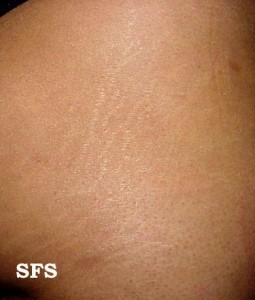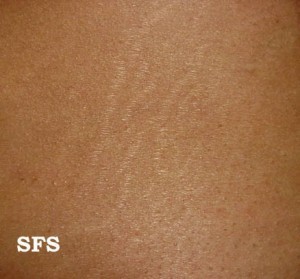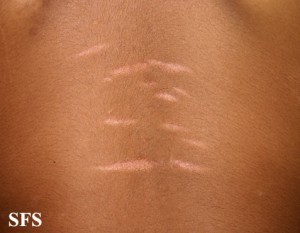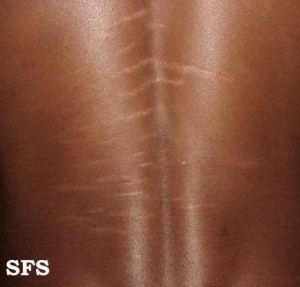Stretch Marks (Striae) Causes, Pictures, Remedies, Treatment
It is one of the common skin conditions that affects many people, but stretch marks are usually not a medical concern. For women in particular, it is almost considered to be an eventuality at some point in life, particularly after pregnancy. It does not cause any other significant symptoms beyond the cosmetic impact. Nevertheless stretch marks, or the treatment of it, has grown into an industry on its own with countless skin applications and other therapies claiming to be the ‘cure’. As yet, even the advances in medical science have not been able to offer a complete resolution of these bothersome skin blemishes. Understanding how stretch marks develop and what can be done to minimize it is often a more effective approach.
What are stretch marks?
Stretch marks are lines of irregular skin that arise with rapid stretching of the skin. As a result of this stretching, the underlying tissue becomes “torn” and this appears as the characteristic red, purple or white lines. It is a very common condition and affects about 9 out of 10 pregnant women. Even without pregnancy, stretch marks affects about 7 out of 10 adolescent females and about 4 out of 10 adolescent males.
It is not serious in medical terms but sometimes stretch marks may be a symptom of serious medical condition like Cushing syndrome and diabetes. Another term for stretch marks is striae. This simply means lines or bands that are of a different color to the skin. It may also be known as striae atrophica, striae distensae, striae rubra (red color) or striae alba (white color).
How do stretch marks occur?
The skin has a remarkable propensity to stretch without any aberrations, provided that the stretching is gradual and within limits. Rapid stretching will often lead to deformities in the skin structure, like stretch marks. The exact way in which stretch marks arise is not yet completely understood. It appears that the enlargement of an area then causes the skin stretch with breaking of the connective tissue.
It is also believed that a type of immune cell, known as mast cells, release the contents of its granules which are potent immune chemicals. This may lead to damage of the collagen and elastin (connective tissue) fibers that are responsible for skin integrity. It appears that genetic factors may also be at play in the development of stretch marks but the exact mechanism is not completely understood.
What causes stretch marks?
Stretch marks are believed to be a rupture in the connective tissue of the skin. It is caused by rapid distension of an area, either due to fat deposition, muscle hypertrophy (enlargement) or growth like within the pregnant uterus. Therefore stretch marks most often occur as a result of:
- Pregnancy and breastfeeding (lactation)
- Obesity
- Puberty
- Body building
Another factor that contributes to stretch marks is the prolonged use of corticosteroids, either orally or topically. A similar effect may occur with using anabolic steroids. Hormonal disturbances in conditions such as diabetes and Cushing syndrome.
What do stretch marks look like?
Most of us know stretch marks when we see it. Typically these marks appear as white to skin colored lines or bands. However, the early appearance of stretch marks can be confusing to most people. In the early stages, the skin appears thin and pink in color. The initial lesions are flat, and sometimes it may be itchy.
As the condition progresses, it becomes red to purple in color. It typically appears as thin lines, about 1 to 10 millimeters wide but those lesions caused by Cushing syndrome and steroid use are often larger. In time these red to purple lines start to lighten. Eventually it becomes white to somewhat skin-colored and are less conspicuous.
Areas where stretch marks occur
Stretch marks could occur on any part of the body, but it is more likely to occur over certain areas. These areas of the skin are most affected by fat deposition and tissue growth for one or more of the reasons discussed above.
- Breasts, buttocks and thighs in adolescents.
- Abdomen and breasts in pregnant women.
- Shoulders in body-builders.
- Hips and flanks may also be affected in any person, especially in people who are obese.
Although uncommon, stretch marks can occur on the face but this is more likely to occur with stretch marks caused by Cushing syndrome.
Pictures of stretch marks
These pictures have been sourced from the Dermatology Atlas Brazil (http://atlasdermatologico.com.br).
Stretch Mark Remedies
There are a number of cosmetic and OTC (over-the-counter) products advocated for preventing or even curing stretch marks. Most do not work. However, it may not cause any harm and can be tried. Some of these remedies that are said to prevent or fade stretch marks include:
- Cocoa butter
- Glycolic acid
- Marigold (Calendula officinalis) extract
- Oils such as olive oil
- Vitamin E (oils and creams)
Pregnant women should be cautious about using some of these remedies during pregnancy. It has become a common practice for moisturizing oils containing one or more of the ingredients above to be applied on target areas during the course of pregnancy. However, some may be contraindicated in pregnancy, although most of these cosmetic and OTC products are mild, do not penetrate the deeper layers of the skin and generally do not pose any risk.
Treatment and Prevention
Topical applications like tretinoin (vitamin A derivative) may be applied for stretch marks, and has to be prescribed by a doctor. Tretinoin is widely used for treating acne. However, there is evidence to suggest that it could help to some degree with early stretch marks, that are not more than a few months old. It should not be used by pregnant women. Other treatments such as laser therapy and microdermabrasion may help to stimulate collagen and/or elastin production. Neither tretinoin nor laser therapy and microdermabrasion are a guarantee of removing stretch marks.
How to stop stretch marks?
If the reason for the stretching of the skin can be reversed, then it is possible for stretch marks in the early stages to resolve to a large degree. Weight gain is by far the main problem so stopping further weight gain and losing the weight that has accumulated can be helpful. It is not possible to stop stretch marks entirely but by preventing the conditions that cause it, stretch marks can be avoided.




